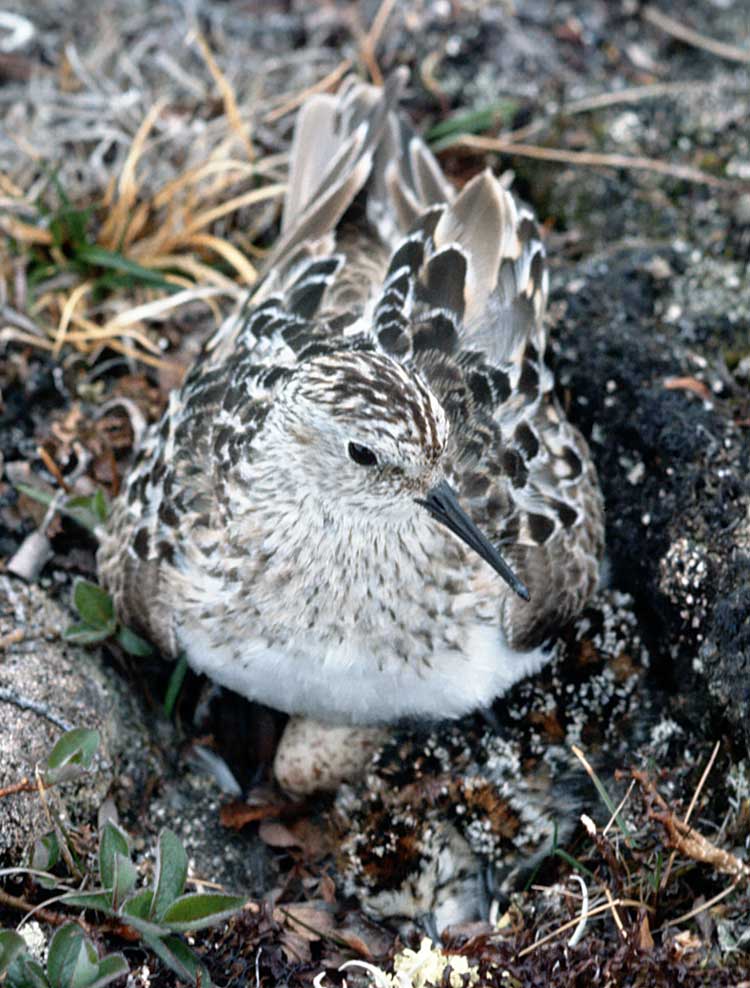
Calidris bairdii(*)
Superregnum: Eukaryota
Cladus: Unikonta
Cladus: Opisthokonta
Cladus: Holozoa
Regnum: Animalia
Subregnum: Eumetazoa
Cladus: Bilateria
Cladus: Nephrozoa
Superphylum: Deuterostomia
Phylum: Chordata
Subphylum: Vertebrata
Infraphylum: Gnathostomata
Megaclassis: Osteichthyes
Cladus: Sarcopterygii
Cladus: Rhipidistia
Cladus: Tetrapodomorpha
Cladus: Eotetrapodiformes
Cladus: Elpistostegalia
Superclassis: Tetrapoda
Cladus: Reptiliomorpha
Cladus: Amniota
Classis: Reptilia
Cladus: Eureptilia
Cladus: Romeriida
Subclassis: Diapsida
Cladus: Sauria
Infraclassis: Archosauromorpha
Cladus: Crurotarsi
Divisio: Archosauria
Cladus: Avemetatarsalia
Cladus: Ornithodira
Subtaxon: Dinosauromorpha
Cladus: Dinosauriformes
Cladus: Dracohors
Cladus: Dinosauria
Ordo: Saurischia
Cladus: Eusaurischia
Subordo: Theropoda
Cladus: Neotheropoda
Cladus: Averostra
Cladus: Tetanurae
Cladus: Avetheropoda
Cladus: Coelurosauria
Cladus: Tyrannoraptora
Cladus: Maniraptoromorpha
Cladus: Maniraptoriformes
Cladus: Maniraptora
Cladus: Pennaraptora
Cladus: Paraves
Cladus: Eumaniraptora
Cladus: Avialae
Infraclassis: Aves
Cladus: Euavialae
Cladus: Avebrevicauda
Cladus: Pygostylia
Cladus: Ornithothoraces
Cladus: Ornithuromorpha
Cladus: Carinatae
Parvclassis: Neornithes
Cohors: Neognathae
Cladus: Neoaves
Ordo: Charadriiformes
Subordo: Charadrii
Familia: Scolopacidae
Genus: Calidris
Species: Calidris bairdii
Name
Calidris bairdii (Coues, 1861)
Synonyms
Actodromas bairdii (protonym)
Ereunetes bairdii
Erolia bairdii
Pisobia bairdii
References
Proceedings of the Academy of Natural Sciences of Philadelphia 13: 194.
Vernacular names
Afrikaans: Bairdse Strandloper
brezhoneg: Sourouc'han-Baird
català: Territ de Baird
čeština: Jespák dlouhokřídlý
Cymraeg: Pibydd Baird
dansk: Bairdsryle
Deutsch: Bairdstrandläufer
Ελληνικά: Λιβαδοσκαλίδρα
English: Baird's Sandpiper
Esperanto: Flavbrusta kalidro
español: Correlimos de Baird
eesti: Eskimo rüdi
euskara: Territ de Baird
suomi: Eskimosirri
føroyskt: Slankugrælingur
français: Bécasseau de Baird
Gaeilge: Gobadáinín Baird
Gàidhlig: Trìlleachan Glas
galego: Pilro de Baird
Avañe'ẽ: Chululu'i
עברית: חופית בירד
Kreyòl ayisyen: Bekasin zèl long
magyar: Baird-partfutó
íslenska: Leirutíta
italiano: Gambecchio di Baird
ᐃᓄᒃᑎᑐᑦ/inuktitut: Tweetwee
日本語: ヒメウズラシギ
Latina: Calidris bairdii
lietuvių: Ilgasparnis bėgikas
Nederlands: Bairds strandloper
norsk: Gulbrystsnipe
polski: Biegus długoskrzydły
português do Brasil: Maçarico-de-bico-fino
português: Pilrito de Baird
русский: Бэрдов песочник
slovenčina: Pobrežník plavý
slovenščina: Vrtorepi prodnik
svenska: Gulbröstad snäppa
Türkçe: Uzun kanatlı kumkuşu
中文: 白腹滨鹬
Baird's sandpiper (Calidris bairdii) is a small shorebird. It is among those calidrids which were formerly included in the genus Erolia, which was subsumed into the genus Calidris in 1973.[2] The genus name is from Ancient Greek kalidris or skalidris, a term used by Aristotle for some grey-coloured waterside birds. The English name and specific bairdii commemorate Spencer Fullerton Baird, 19th-century naturalist and assistant secretary of the Smithsonian Institution.[3]
Description
Adults have black legs and a short, straight, thin dark bill. They are dark brown on top and mainly white underneath with a black patch on the rump. The head and breast are light brown with dark streaks. In winter plumage, this species is paler brownish gray above. This bird can be difficult to distinguish from other similar tiny shorebirds; these are known collectively as "peeps" or "stints".
One of the best identification features is the long wings, which extend beyond the tail when the bird is on the ground. Only the white-rumped sandpiper also shows this, and that bird can be distinguished by its namesake feature.
| Standard Measurements[4][5] | |
|---|---|
| length | 180–190 mm (7–7.6 in) |
| weight | 38 g (1.3 oz) |
| wingspan | 430 mm (17 in) |
| wing | 117.6–125.3 mm (4.63–4.93 in) |
| tail | 50–57 mm (2.0–2.2 in) |
| culmen | 20.5–24.5 mm (0.81–0.96 in) |
| tarsus | 21.3–24.2 mm (0.84–0.95 in) |
Ecology
Chicks on the ground, camouflaged
Eggs in a nest
Baird's sandpipers breed in the northern tundra from eastern Siberia to western Greenland. They nest on the ground, usually in dry locations with low vegetation.
They are a long-distance migrant, wintering in South America. This species is a rare vagrant to western Europe.
Baird's sandpiper might have hybridized with the buff-breasted sandpiper.
These birds forage by moving about mudflats, picking up food by sight. They mainly eat insects, also some small crustaceans.
References
BirdLife International (2018). "Calidris bairdii". IUCN Red List of Threatened Species. 2018: e.T22693404A129653281. doi:10.2305/IUCN.UK.2018-2.RLTS.T22693404A129653281.en. Retrieved 12 November 2021.
Ryser, Fred A. (1985). Birds of the Great Basin: A Natural History. Reno, NV, US: University of Nevada Press. p. 193. ISBN 0-87417-080-X.
Jobling, James A (2010). The Helm Dictionary of Scientific Bird Names. London: Christopher Helm. pp. 66, 84. ISBN 978-1-4081-2501-4.
Godfrey, W. Earl (1966). The Birds of Canada. Ottawa: National Museum of Canada. p. 154.
Sibley, David Allen (2000). The Sibley Guide to Birds. New York: Knopf. p. 185. ISBN 0-679-45122-6.
Retrieved from "http://en.wikipedia.org/"
All text is available under the terms of the GNU Free Documentation License

